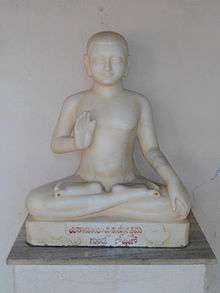Siddhasena
| Acharya Shri 108 Siddhasena Divakara Ji Maharaj | |
|---|---|
 Image of digambar acharya (head of the monastic order) | |
| Religion | Jainism |
| Sect | Digambara |
| Personal | |
| Born | 5th century CE |
| Died | 5th century CE |
| Works | Nyāyāvatāra |
| Part of a series on |
| Jainism |
|---|
 |
|
Jain prayers |
|
Ethics |
|
Major sects |
|
Festivals |
|
|
Siddhasēna Divākara (Magadhi Prakrit: सिद्दसेन दिवाकर) was an Digambara monk in the fifth century CE who wrote works on Jain philosophy and epistemology.[1] He was like the illuminating lamp of the Jain order and therefore came to be known as Divākara "Lamp-Maker". He is credited with the authorship of many books, most of which are not available. Sanmatitarka (‘The Logic of the True Doctrine’) is the first major Jain work on logic written in Sanskrit.[2][3]
Life
Siddhasena Divakara is said to have lived from 500 CE to 610 CE. He was a Brahmin by birth and a scholar. He was initiated by Acharya Vruddhavadi.[4] According to the tradition, Siddhasena Divakara once planned to translate all the Jaina works from prakrit to Sanskrit. He was asked by his master to visit all the Jain temples as a punishment. He thus visited the Jain temples for twelve years. He then came upon a Linga temple in Ujjain. He slept at the temple with his feet towards the Linga, which is a symbol of Shiva. King Vikramaditya had him beaten for the sin on request of the devotees. However, with miraculous powers, Siddhasena Divakara made that the King's wife received the beating instead of him. He was then set free. He broke the Linga by raising his hand and an idol of Parshvanatha emerged from there.[5]
Thought
Siddhasena's main contribution in the Sanmatitarka is his analysis of the Jain theory of Anekantavada. According to Jeffery Long, Siddhasena divides two the seven classical Jain nayas (stadpoints, viewpoints) into two categories: "those which affirm the substantiality of existence (dravyāstikanayas) and those which affirm the impermanent, changing aspects of existence (paryāyāstikanayas)."[1] This view sees the best account of reality as one which includes permanence and impermanence, identity and difference in a complex set of contradictory relations. Siddhasena also argued that the number of possible nayas or viewpoints of reality is potentially limitless.[1] He then goes on to correlate each of the nayas with the positions of Indian philosophical schools, showing how each view is only a partial, one sided view.
Works
He was the author of Sammati-tarka-prakarana and is said to have written the Nyāyāvatāra, Sanmati sutra and Kalyan Mandir stotra.[4][6]
Notes
- 1 2 3 Long 2009, p. 132.
- ↑ Qvarnström, Olle; Jainism and Early Buddhism: Essays in Honor of Padmanabh S. Jaini, page 154.
- ↑ Dundas 2002, p. 131.
- 1 2 Natubhai Shah 2004, p. 49.
- ↑ von Glasenapp 1999, pp. 126–127.
- ↑ Balcerowicz & Mejor 2004, p. 313.
References
- Balcerowicz, Piotr; Mejor, Marek, eds. (2004) [2002], Essays in Indian Philosophy, Religion and Literature (First Indian ed.), Delhi: Motilal Banarsidass
- Dundas, Paul (2002) [1992], The Jains (Second ed.), London and New York: Routledge, ISBN 0-415-26605-X
- Long, Jeffery D. (2009), Jainism: An Introduction, I.B. Tauris, ISBN 978-1-84511-625-5
- Shri Abhidhan Rajendra Kosh Vol 5, written by Acharya Rajendrasuri (1827–1906)
- Shah, Natubhai (2004) [First published in 1998], Jainism: The World of Conquerors, I, Motilal Banarsidass, ISBN 81-208-1938-1
- von Glasenapp, Helmuth (1999), Jainism: An Indian Religion of Salvation [Der Jainismus: Eine Indische Erlosungsreligion], Shridhar B. Shrotri (trans.), Delhi: Motilal Banarsidass, ISBN 81-208-1376-6